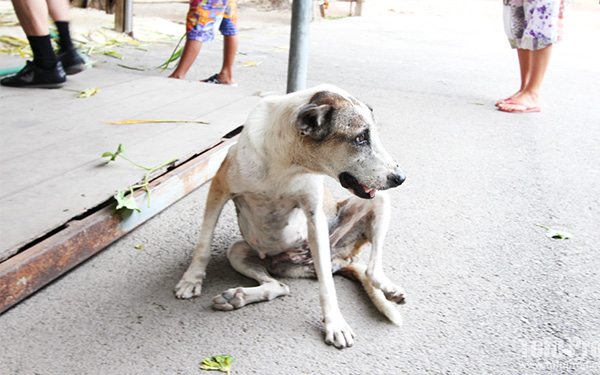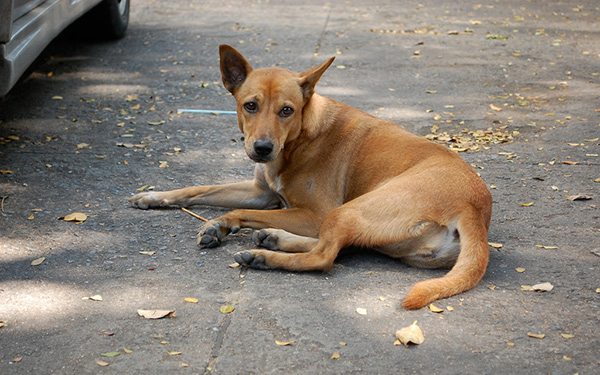There are approximately 300,000 soi dogs roaming the streets of Bangkok.
This is a rather large problem, which has led to some even bigger, radical solutions proposed as to how we go about fixing it, like… why don’t we just euthanize them all?
Yes, this in fact surprised me as one of the more “brilliant” ideas as to how to help these (for the most part) innocent creatures that have only become a problem for human beings thanks to the neglect of humans in the first place.
A few problems arise with this notion that in order to solve the problem, we should just kill the entirety of the street dog population, however.

By Tofuprod (Creative Commons)
For one, 95% of the population in Thailand practices Buddhism. My bet is that anyone who thinks killing these dogs is the answer is going to be hard-pressed to actually find someone willing to do it. Sukhumvit Veterinarians offer everything from dental prophylaxis services to behavioral counseling on their website, but I could not find anything about euthanasia.
I am also curious as to who is going to pay for all of this death serum. Certainly those who are suggesting this as the solution are not going to up and spend anywhere from $50-$200 a dog to have an animal put to sleep.
Don’t get me wrong, I support animal euthanasia in cases where the animals are terminally ill and have no quality of life left. And while the quality of life for these street dogs is certainly not high, between lack of food, the heat, diseases, infections and much more, that is not to say that they could not be living a full life if given the chance.
I could go on and on about how this is just downright murder and an overall lazy solution to the problem, but instead of dwelling on bad ideas, I think we should build upon realistic ones.

By Andrew and Anne-Marie (Creative Commons)
I think it’s important we all consider why it is these animals are out on the streets in the first place — because of people; just like me and everyone else reading this.
My best guess is this: a family bought a cute, cuddly dog with every intention of loving the little thing until something incredible happened — it was not so cute and cuddly anymore.
The dog grew up. It picked up a few habits they were not the most fond of, including chewing on shoes and barking on occasion. Maybe the family never properly trained the dog to use the restroom outside and found it incredibly annoying when it piddled on the carpet.
And now, somehow, this dog ended up on the street.
The list of possibilities goes on and on, with seemingly one thing stringing them all together: humans being at the forefront of the problem.

By ElsieNessie (Creative Commons)
The irony is, however, that the only solution or relief these dogs may receive are from humans.
They must rely on a friendly person making merit for their food intake. They must rely on humans for shelter from the heavy rain during monsoon season, if they’ll allow the dogs near their restaurants or homes for protection. They must rely on people for help when they’ve been run over by a heartless taxi driver and left for dead.
I’m putting this article together because of a video polluting my newsfeed recently.
Many of you may have seen the taxi driver in Bangkok who seemingly made note of a soi dog in the road before proceeding to run it over and continue on their way.
[Be mindful that this is a distressing video]
I could not continue watching after the initial hit, and I felt heavy for the entirety of the afternoon because of it.
Many others viewing this video will think to themselves the same thing I did: I hope the driver is caught and rightfully punished. That being said, very few will make any effort to ensure more dogs like the one seen in the video are off the streets in the first place.
I should not blame everyone, as there are amazing organizations throughout Thailand working tirelessly to reduce the soi dog population. Khlongdogs is a private charity created and funded by Thomas and Paporn Jäkel.
I met them while writing a story on the plight of street dogs in Bangkok, and I was overwhelmed by their kindness towards these animals. While receiving my TESOL certification, I also got to see the inner-workings of Rescue Paws, an organization based in Hua Hin that works tirelessly to vaccinate and sterilize stray animals as well as adopt them to suitable families all over the world. Thai Street Paws Rescue down in Songkhla also does excellent work.
Remember what I said about there being more than 300,000 strays in Bangkok alone? Let’s do some simple math here.
There are approximately 8,280,925 people living in Bangkok, according to the most recent 2010 census. Considering that was six years ago, it’s probably safe to say that the population has grown since then.
Common sense tells us that there are more people living in Bangkok than there are street dogs, meaning if everyone took in just one street dog, there wouldn’t be any at all (with a whopping 7,980,925 people leftover).
There are millions of little things we could be doing to make this large problem a bit smaller too.

By Eli Duke (Creative Commons)
Don’t purchase puppies at markets from breeders; maybe feed the stray that lives on your block every once in awhile; and donate to organizations that help these dogs when you can.
I can’t ask or tell everyone that they must adopt a street dog: many of these dogs are beyond help, and living with the very people who abandoned them in the first place might be harder than living on the street. But it is entirely possible for us to evaluate the problem, offer possible solutions and build upon them in hopes of having just one less dog on the street.
Featured image is by ElsieNessie and used under a CC BY-SA 2.0 licence

